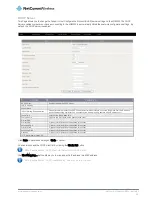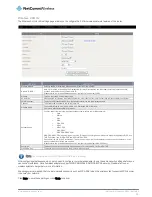
www.netcommwireless.com
NetComm Wireless 4GM3W User Guide
35
There are two types of filtering policies:
Allow all data traffic to pass except those that match the specified rules.
Deny all data traffic to pass except those that match the specified rules.
You can specify up to 48 filtering rules for each direction (Inbound or Outbound). For each rule you will need to define the
following:
Source IP address
Source port
Destination IP address
Destination port
Protocol: TCP or UDP or both.
Use Schedule Rule#
For source or destination IP address, you can define a single IP address (192.168.20.1) or a range of IP addresses
(192.168.20.100-192.168.20.200). Leaving these fields empty implies all IP addresses are matched.
For source or destination port, you can also define a single port (80) or a range of ports (1000-1999). Use the prefix "T" or "U" to
specify either the TCP or UDP protocol e.g. T80, U53, U2000-2999. No prefix indicates both
TCP and UDP are defined. Leaving this field empty implies all ports are matched.
The Packet Filter also works with Scheduling Rules, and gives you more flexibility on Access control.
Note: For further instructions on scheduling rules, please refer to the “Scheduling” section later in this guide
Click Save to save the settings or Undo to cancel.
Inbound Filter:
To access the Inbound Packet Filter page, click on the Inbound Filter button on the bottom of the Outbound Filter page. All the
settings on this page are the same as those for the Outbound Filter shown on the previous page.
Click Save to save the settings or Undo to cancel.






























